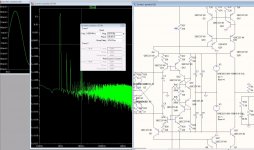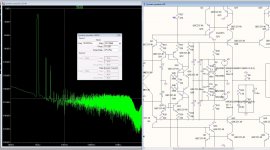If i just have a LED string,, then there will run app 10 mA through them, here Its limited to app 2.5 mA, hmm... setting the voltage inside something,, is not so trivial...apart from using Zeners, which are said to be noisy, Will this noise bleed through..?? High rejection on the mirror and...the cascode..
Here I have inserted a dual voltage souce wit 1 mV 10KHz (noise) to see just how much a such a noise will bleed into the output, the result is that the suppression is rather large as 2mV (peak peak) becomes app 30uV, or app 70 times lower than than the zener noise injected into the circuit...
I vote for a simple 12 V-zener...
Here I have inserted a dual voltage souce wit 1 mV 10KHz (noise) to see just how much a such a noise will bleed into the output, the result is that the suppression is rather large as 2mV (peak peak) becomes app 30uV, or app 70 times lower than than the zener noise injected into the circuit...
I vote for a simple 12 V-zener...
Attachments
If i just have a LED string,, then there will run app 10 mA through them, here Its limited to app 2.5 mA, hmm... setting the voltage inside something,, is not so trivial...apart from using Zeners, which are said to be noisy, Will this noise bleed through..?? High rejection on the mirror and...the cascode..
Here I have inserted a dual voltage souce wit 1 mV 10KHz (noise) to see just how much a such a noise will bleed into the output, the result is that the suppression is rather large as 2mV (peak peak) becomes app 30uV, or app 70 times lower than than the zener noise injected into the circuit...
I vote for a simple 12 V-zener...
Not all zeners are noisy, but this needs a good low noise zener.
Your TD160 with SME3009 should beat any Rega P3 in any situation.
I do think so
MiiB, i like the modification to the buffer and also that you supply all cacodes from the same voltage divider.
The problem now focusses on the bias spreader for the input stage.
An Ube multiplier will certainly work, so does a zener.
Frans, do you know a low noise zener ?
The problem now focusses on the bias spreader for the input stage.
An Ube multiplier will certainly work, so does a zener.
Frans, do you know a low noise zener ?
MiiB, i like the modification to the buffer and also that you supply all cacodes from the same voltage divider.
The problem now focusses on the bias spreader for the input stage.
An Ube multiplier will certainly work, so does a zener.
Frans, do you know a low noise zener ?
Not specificaly, all data that I have (Motorola internal files) is almost 30 years old. (and at home).
Zeners near 3.6Volt are the least noisy available, so you want to use a few in series, also add a resistor in series with the zener(s) (about a volt across it (if the zeners are at 10mA use a 100 Ohm resistor)) and add a capacitor in parallel to the zener(s) (100uF or there about). Using 3 zener diodes for a total of slightly less than 12Volts seems fine to me.
Sorry, I cannot model or draw anything at the moment, needs to wait until I am back at home.
These are very good, anyone, do you know where to get these?
http://www.aeroflex.com/ams/Metelics/pdfiles/1N5518-1N5546.pdf
Last edited:
From what I understand of zeners is that highest noise is generated when zener is operated at or nearest their transition regions. A 8 v zener can have noise figures similar to a string of LEDs. The lowest noise one can get fron zeners is when they are temperature compensated but unfortuneatly these can be very very expensive. Some made by microsemi can cost upto 50 dollars but have guaranteed noise figures less than that of a LED but you only see them used in sensitive space satilites.
I dont have data on 3.6 v zener noise but instead of that I think Id create temp compensated zener by combining a normal zener with a signal diode and get very low tempco. This is how tempco diodes are made btw. I think a 12 v zener made this way will have much lower noise than a string of 3 in series.
FdW could you explain the advantage in 3.6 v zeners.
1n829 is example of very low noise zener.
I dont have data on 3.6 v zener noise but instead of that I think Id create temp compensated zener by combining a normal zener with a signal diode and get very low tempco. This is how tempco diodes are made btw. I think a 12 v zener made this way will have much lower noise than a string of 3 in series.
FdW could you explain the advantage in 3.6 v zeners.
1n829 is example of very low noise zener.
Last edited:
From what I understand of zeners is that highest noise is generated when zener is operated at or nearest their transition regions. A 8 v zener can have noise figures similar to a string of LEDs. The lowest noise one can get fron zeners is when they are temperature compensated but unfortuneatly these can be very very expensive. Some made by microsemi can cost upto 50 dollars but have guaranteed noise figures less than that of a LED but you only see them used in sensitive space satilites.
I dont have data on 3.6 v zener noise but instead of that I think Id create temp compensated zener by combining a normal zener with a signal diode and get very low tempco. This is how tempco diodes are made btw. I think a 12 v zener made this way will have much lower noise than a string of 3 in series.
FdW could you explain the advantage in 3.6 v zeners.
1n829 is example of very low noise zener.
None of the datasheets I checked for the 1n829 specify it as a low noise device, none of those datasheets did specify noise figures, so, I cannot conform (or deny).
In general zener diodes with an lower voltage generate less pop noise.
Check the noise values given for these:
http://www.aeroflex.com/ams/Metelics/pdfiles/1N5518-1N5546.pdf
(it shows, low voltage zener diodes generate less noise)
None of the datasheets I checked for the 1n829 specify it as a low noise device, none of those datasheets did specify noise figures, so, I cannot conform (or deny).
In general zener diodes with an lower voltage generate less pop noise.
Check the noise values given for these:
http://www.aeroflex.com/ams/Metelics/pdfiles/1N5518-1N5546.pdf
(it shows, low voltage zener diodes generate less noise)
Not 'pop'- but 'avalanche'-noise
Some information con be found here: http://www.ciphersbyritter.com/RES/NOISE.HTM#Horowitz89
Last edited:
That is the one company that sells them :
TTI Inc. | Electronic Component Distributor
As far as i can tell from the data sheet a string of 3,9V diodes is much less noisy then a 12V single.
TTI Inc. | Electronic Component Distributor
As far as i can tell from the data sheet a string of 3,9V diodes is much less noisy then a 12V single.
With this Zener arrangement-filtering and 2uV injected 10 KHz noise, It's by no mean visible, Think it's a plenty-good solution, and if we can agree on this, we can freeze the design...and the nice PCB wizard's can go to work...
michael
michael
Attachments
This thread is good reading on LED and zener noise
http://www.diyaudio.com/forums/parts/35821-some-noise-measurements-leds-zener-diodes.html
http://www.diyaudio.com/forums/parts/35821-some-noise-measurements-leds-zener-diodes.html
This should be one of the lowest noise diode on the market,,(at least to my internet findings) They cost app a little more than 1 euro each...this is a temperature compensated Zener with low noise and no thermal drift (1N829)
http://www.datasheetcatalog.org/datasheet/motorola/1N823.pdf
http://www.datasheetcatalog.org/datasheet/motorola/1N823.pdf
Ok, lets do the Zener solution. The Motorolas will do the job and then we have RC filtering.
From my side, lets freeze it and let the artists do their thing.
As in 3654 is fine with me.

